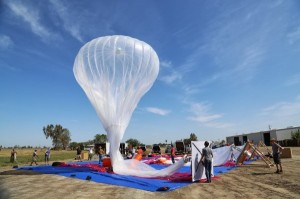By Erica Rascón on June 20, 2013 in Technology

As a Peace Corps volunteer serving in rural Paraguay, I encountered moments when a quick internet search would have been a blessing. The resource could help with verb conjunction as I fumbled through Spanish or event planning during the rainy season. I shrugged off the inconvenience as part of the job. Away from the city, internet connectivity simply wasn’t an option. Now, an exciting new project delivers life-altering internet connectivity for isolated communities.
Google’s recent launch of super pressure balloons, dubbed Project Loon, has drawn attention to the emergence of balloon-based internet connectivity. Space Data and World Surveillance Group have launched similar projects, mainly for military purposes. Google is the first to use the technology to bring 3G speeds to remote areas for civilian use. The company is also the first to attempt long-term operations using the balloons, currently up to 100 days.
If it works out, here are the kinds of problems that Project Loon could solve:
Back in 2010, my Paraguayan students were in a frenzy over the FIFA World Cup. I jumped on the opportunity to turn their fanaticism into a learning experience. We began a geography series highlighting dominant teams like Spain, Brazil, Uruguay, and the Netherlands.
As I began the class session on Japan, I remembered a college friend who was teaching in Tokyo at the time. I thought: How awesome would it be to have our students interact with each other in real time. They could see one another’s faces and take a little tour of each other’s worlds.
In my rural station, access to basic necessities was scarce. Forget smartphones and data plans. The infrastructure simply was not available. Google’s balloon-based connectivity could change that.

On a larger scale, balloon-based connections permit nonprofits, hospitals, and businesses in developing regions to work more efficiently without extensive infrastructure. Emergency response organizations can stay abreast of developments even when ground connections are damaged or inaccessible. Medical professionals can receive critical updates and remote training without traveling hours, sometimes days, to more developed cities in the region. Educational and research opportunities abound.
I shared the news of Google’s Project Loon with my former co-worker, Don Roman Ovando. He is the founder of the Ogaguasu Cultural Center in Mboi’y.
“Their potential is undeniable,” he began. “I can’t wait until something like that is available here!” His vision for Project Loon immediately focused on local youth.
He explained that many students in Mboi’y cannot afford to travel to universities in far-off cities. Through Project Loon, online classes would bring education to their doorsteps. Local teachers could continue their educations online, he said, and provide fresh insights for struggling rural schools.
Don Ramon finally began to think of his own small business. He became increasingly enthusiastic as he fluidly voiced his dreams: “We could host fundraisers online, put ads out on the web to draw more attention to our tiny cultural center. People come into town for the Motocross. What if the same amount of people came for our festivals, for the arts and craft show, Expo Feria Kachape? With more exposure for Ogaguasu, we could bring revenue to the town from a bit of cultural tourism! We could get more street lights and maybe a bigger water tank. Think of the research we could do online. It would be easier to research and create archives of our town’s history, of our dear language [Guarani], and our folklore.”
I told Don Ramon about the storage capabilities of the Cloud.

“Dios mio,” he sighed. His excitement reached a denouement. “I hope they get the balloons to work here soon,” he said after a pause.
Google is admittedly still working out the kinks. Only 30 balloons have been placed into the stratosphere, providing intermittent internet connection to the ground below. There are currently 50 testers in the countryside of New Zealand that track the balloons. Developers are also attempting to regulate the travel patterns of the devices.
Cynics stay close on the heels of all innovations. Critics of Project Loon doubt that the company will find a sound solution for navigating the balloons in the turbulent and demanding field of near earth. The project also faces a rash of technical obstacles but Google is pressing forward. Learning from trial and error doesn’t seem to faze the technology giant.
Fans of the project, like Don Ramon, believe that the endeavor is worth every effort. “So much could change for a small town like us without having to wait on the big city government for everything. All that potential from some balloons. Imagine that!”


